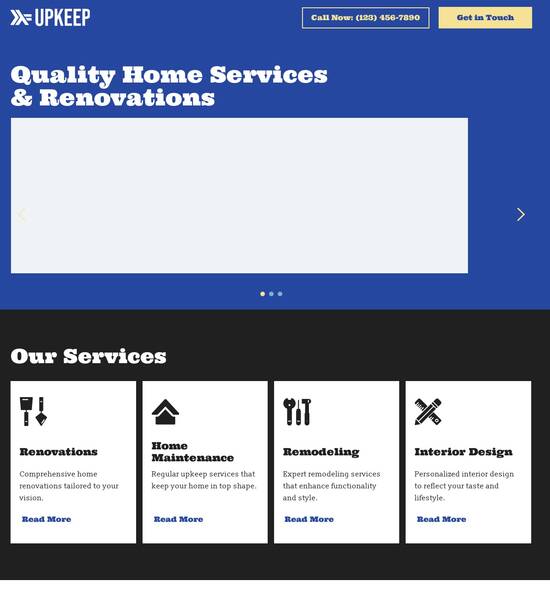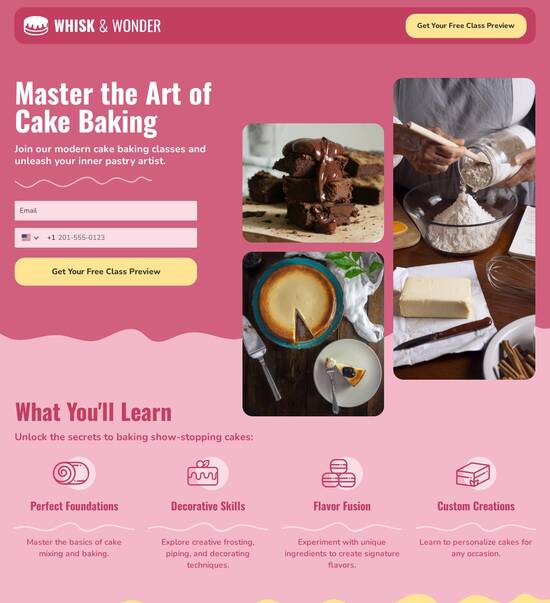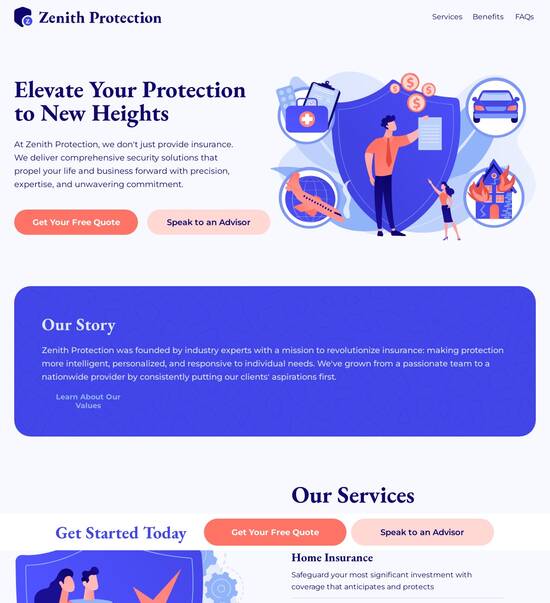
HTML page template for revenue cycle management companies
Use TemplateAbout template
Give your revenue cycle management companies a boost with our professional landing page templates. Ready to turn visitors into customers?
Recommended templates

Easy to build without coding
With the intuitive drag-and-drop builder, anyone on your team can create high-converting pages without any knowledge of code or design. Make enhancements to your landing page with custom widgets using Javascript, HTML/CSS, or third-party scripts.

Multiple layouts for any industry and goal
Select from 500+ landing page layouts built to boost conversions across industry-specific scenarios. Customize them by adjusting fonts, adding images, and generating on-brand content with the AI assistant. Quickly scale with Instablocks® and Global Blocks that you can save, reuse, and update globally.

Loads fast and looks polished on any device
Every template is responsive, which means they present professionally on any device and load blazingly fast with our Thor Render Engine. You can also power them up with Google AMP technology to deliver an unparalleled mobile experience and drive higher conversions.

Robust analytics & experimentation
Get real-time updates and reporting across all your devices, showing the number of visitors, conversions, cost-per-visitor, and cost-per-lead. Launch AI-powered experiments, run A/B tests, and use heatmaps to analyze user behavior, then optimize your landing page to maximize conversions.







Easy to build without coding
With the intuitive drag-and-drop builder, anyone on your team can create high-converting pages without any knowledge of code or design. Make enhancements to your landing page with custom widgets using Javascript, HTML/CSS, or third-party scripts.
Multiple layouts for any industry and goal
Select from 500+ landing page layouts built to boost conversions across industry-specific scenarios. Customize them by adjusting fonts, adding images, and generating on-brand content with the AI assistant. Quickly scale with Instablocks® and Global Blocks that you can save, reuse, and update globally.
Loads fast and looks polished on any device
Every template is responsive, which means they present professionally on any device and load blazingly fast with our Thor Render Engine.
Robust analytics & experimentation
Get real-time updates and reporting across all your devices, showing the number of visitors, conversions, cost-per-visitor, and cost-per-lead. Launch AI-powered experiments, run A/B tests, and use heatmaps to analyze user behavior, then optimize your landing page to maximize conversions.
All the features you need to build lead-generating landing pages
Explore more featuresLearn how to build top-performing landing pages for any goal
FAQs
Leading the way in building high-performing landing pages





Enhance your marketing strategy with Instapage’s landing page templates
Utilizing Instapage's advanced landing page templates can dramatically enhance your marketing campaigns by improving user engagement and conversion rates. With ready-to-use and customizable templates tailored for various industries, you can streamline your processes without compromising on creativity.
Understanding the significance of landing pages
Landing pages serve as a critical component in your marketing funnel. They are the first interaction point for potential clients, hence they must effectively capture interest. A well-optimized landing page can lead to increased conversions, making it essential to leverage Instapage’s robust features designed for high impact.
- User-Friendly Design: Instapage provides an intuitive drag-and-drop interface allowing marketers of all skill levels to create stunning landing pages without the need for coding.
- A/B Testing Capabilities: Instapage enables real-time experimentation with various designs and content to find what resonates best with your audience.
- In-depth Analytics: Track the performance of your landing pages with analytics dashboards that provide insights on user behavior, enabling data-driven decisions.
Step 1: Selecting the right template for your campaign
Choosing the right landing page template is crucial. Consider the goals of your campaign—whether it’s lead generation, product promotion, or event registration. Instapage’s vast library can guide you in selecting a design that aligns with your objectives.
- Know your audience: Tailor your template based on the specific needs and preferences of your target audience.
- Define your goal: Ensure your selected template aligns with the primary goal of your landing page.
- Visual appeal: Choose designs that are not only functional but also visually compelling to capture attention.
Step 2: Customizing your landing page
Once you’ve selected a template, it’s time to customize it. Instapage allows for extensive personalization, letting you modify layout elements, text, images, and calls-to-action to better resonate with your audience.
- Include strong CTAs: Ensure that your call-to-action buttons are prominent and enticing to guide users toward your goal.
- Use engaging visuals: Incorporate high-quality images or videos that reflect the message of the landing page.
- Personalization features: Utilize dynamic text replacement to create personalized experiences based on user data.
Step 3: Launching and optimizing your landing page
After customization, it's time to launch your landing page. But the process doesn't stop there. Leverage Instapage’s optimization tools such as A/B testing and heatmaps to continuously enhance performance based on user interactions.
Regularly iterating and optimizing your landing pages will ensure they remain effective in achieving your marketing goals.
Ready to maximize your marketing efforts? Start creating high-converting landing pages today with Instapage's powerful tools and get the results you’ve always wanted.
HTML page template for revenue cycle management companies
The role of HTML page templates in enhancing revenue cycle management
In the rapidly evolving healthcare sector, Revenue Cycle Management (RCM) plays a pivotal role in ensuring that healthcare providers receive timely and accurate reimbursements for services rendered. One of the pivotal tools that can significantly enhance the efficiency of RCM is the use of HTML page templates. These templates not only streamline workflows but also facilitate a user-friendly experience for both providers and patients. By ensuring that essential information is presented clearly and effectively, HTML page templates can aid in minimizing discrepancies and delays in revenue collection.
Understanding revenue cycle management (RCM)
Revenue Cycle Management refers to the financial process that healthcare organizations use to track patient care episodes from registration and appointment scheduling to the final payment of the balance. This covers a wide array of activities including eligibility verification, coding, billing, collections, and managing denials. The importance of streamlined revenue flows is paramount for maintaining operational efficiency and ensuring a healthy cash flow.
An overview of the healthcare revenue cycle illustrates the multifaceted approach required to manage finances effectively. A well-designed revenue cycle flowchart can help visualize each step and the information needed at each phase, highlighting the critical points of interaction between patients, providers, and payers.
The impact of HTML page templates on RCM companies
HTML page templates offer significant advantages to RCM companies. One of the most notable benefits is the automation of routine tasks. Automation minimizes human error and frees up staff to focus on higher-level responsibilities, ultimately improving productivity. For instance, having pre-designed templates for billing reminders or patient communications can save time and reduce operational costs.
Additionally, these templates enhance user experience through thoughtful design. An effective user interface can guide users through complex processes such as claims submission or payment collection. By creating a more intuitive experience, RCM companies can significantly lower frustration and improve overall satisfaction for both staff and patients.
Moreover, as RCM needs evolve and grow, scalable web solutions can be developed through the use of HTML templates. This flexibility allows companies to adapt their websites quickly in response to shifts in market demand or regulatory changes.
Essential features of an RCM HTML page template
To create effective HTML page templates for RCM companies, several essential features should be included. Firstly, customizable healthcare revenue flowcharts can be integrated to visualize the revenue cycle effectively. These flowcharts demonstrate the various processes and highlight the interactions between patients and providers.
Integration of customizable healthcare revenue cycle flowchart templates that can adapt to specific organizational norms.
Interactive charts that engage users and allow for deeper understanding of processes.
Ease of modifying elements within the flowchart to ensure accurate representation of current processes.
Another crucial feature is including dynamic content sections. Utilizing both text and rich media allows RCM companies to share information effectively. It's essential to keep in mind the structure of content for SEO purposes as well; well-organized information can naturally attract and retain more visitors.
Creating engaging design elements
Effective design elements are fundamental for an RCM HTML page template. Color schemes and typeface selection are critical as they can greatly influence user perception. The right colors can evoke trust and professionalism, while the typeface maintains brand consistency, ensuring that users feel familiar with the brand.
Selecting colors that align with the healthcare branding.
Choosing a readable and professional typeface that enhances brand recognition.
Headers and titles also play a significant role. Utilizing effective techniques to craft engaging headlines promotes better content absorption. Hierarchical headings help structure information and guide users through relevant sections seamlessly.
Structuring content for maximum impact
Organizing sections within the HTML page template is essential for creating a logical flow. For example, strategic section dividers can help manage transitions between different topics or categories, aiding readers in navigating thoroughly without losing focus.
Creating logical flow with sections that represent different phases of the RCM process.
Utilizing examples of effective section dividers to maintain visual clarity.
Additionally, integrating a gallery for visual engagement can significantly enhance the user's understanding of RCM concepts. By using images and graphics thoughtfully, templates can effectively illustrate data and processes without overwhelming the viewer.
Optimization techniques for increased conversion
A/B testing of layouts and designs is vital for determining which configurations lead to better conversions. By analyzing data-driven decisions, RCM companies can make informed modifications to their templates that directly address user preferences and behaviors.
Importance of understanding conversion metrics to make effective changes.
Strategies for gathering and analyzing user data effectively.
Moreover, SEO and content optimization should also be prioritized. Techniques like optimizing HTML templates for search engines and smart use of relevant keywords can drive consistent organic traffic to the RCM's web pages.
The future of RCM web development
As we consider the future of RCM web development, several emerging trends in HTML templates are becoming apparent. Among these is the increasing personalization of web experiences. With advancements in AI and machine learning, templates are expected to adapt even more to user behavior, creating customized journeys that cater to individual needs.
The potential for AI-driven personalization to influence user experiences.
Trends in design innovations that enhance user engagement.
Furthermore, RCM companies must stay agile in the face of industry challenges and regulations. This includes ensuring compliance with healthcare regulations by developing templates that maintain flexibility in design to adapt to new policies.
Case studies: Success stories of RCM companies utilizing HTML templates
Many RCM companies have successfully implemented HTML templates and have observed significant improvements in their operational efficiency. By comparing performance before and after the use of these templates, organizations can highlight the tangible benefits they have gained.
Before-and-after implementation analyses to highlight key performance indicators.
Positive feedback from RCM professionals on the improved workflow utilizing templates.
Specific outcomes such as increased turnaround times and fewer billing errors attributed to template use.
These success stories underline the importance of utilizing modern HTML templates in transforming RCM processes to become more efficient and user-friendly.
Final thoughts: Transforming revenue cycle management with HTML templates
In summary, implementing effective HTML page templates can significantly enhance revenue cycle management practices. By focusing on best practices, such as optimizing for user experience and SEO, organizations can better navigate the complexities of RCM.
Anticipating future needs in RCM web design to remain competitive.
Continuously adapting to new technologies and user expectations.
Ultimately, RCM companies should foster a culture of continuous learning, keeping teams updated on advancements in web development to better serve their organizational goals and client needs.
Ready to skyrocket conversions?
Supercharge your ad campaigns with high-performing landing pages
Get started














